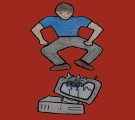
PAC III Computers
617 N Franklin Cuba, MO 65453 573-885-0024
PAC III Computers recommends
NOD32 Anti-Virus
Named the "Best Antivirus Product of 2006" by AV-Comparatives.org
Inside a Computer
If you’re tired of getting a headache every time someone talks about computers then this page is for you. This isn’t a computer science degree but it will help you understand how a personal computer (PC) works.
A PC is a general purpose tool built around a processor. It has lots of different parts (motherboard, memory, hard disk, modem, etc.) that work together. "General purpose" means that you can do many different things with a PC. You can use it to type documents, send e-mail, browse the Web and play games.
Let's take a look at the main components of a typical computer.
Motherboard
The motherboard has been an integral part of most personal computers for more than 20 years. Think of a motherboard as a scale model of a futuristic city with many modular plug-in buildings, each using power from a common electrical system (power supply). Multiple-lane highways of various widths transport data between the buildings. The motherboard is the data and power infrastructure for the entire computer.
Processor
The processor is the "brain" of the computer and is also called the CPU (central processing unit). Everything that a computer does is overseen by the CPU.
RAM (Random Access Memory)
You can think of RAM as a desk. you can lay out the stuff you’re working on and access it very quickly. Of course, the bigger you’re desk the more things you can put on it at one time.
RAM is the best known form of computer memory. RAM is considered "random access" because you can access any part of the contents directly at any given time. As opposed to serial access memory (SAM). SAM stores data as a series of memory cells that can only be accessed sequentially (like a cassette tape).
Hard Drive
A Hard Drive is like a file cabinet. It is large-capacity permanent storage used to hold information such as programs and documents.
CD-ROM Drive
This drive allows you to listen to music CDs, load extra programs, and view files that are stored on a CD. ROM stands for “Read Only Memory” because a CD-ROM drive does not have the ability to write files to a CD.
Floppy Drive
This drive allows you to read and write files to or from a floppy disk.
Power Supply
The power supply converts the electricity from your wall outlet to a form that the internal parts of the computer can use and distributes it to the parts via small connectors that cannot be plugged in backwards.
Operating System
This is the basic software that allows users to communicate with a computer. The most popular operating system is Windows. Others include Macintosh (Mac), Linux, Ubuntu, MS-DOS, and UNIX.
IDE (Integrated Drive Electronics)
This is the interface that hard Drives, CD-ROM drives, and DVD drives use to connect to the computer. The cables used are wide gray cables that contain 40 or 80 separate wires. In the 80 wire cables, half of the wires are used to prevent signals from one wire from interfering with signals in the wires next to it. Modern IDE cables are keyed so that they cannot be plugged in backward.
PCI (Peripheral Component Interconnect)
PCI is currently the most common way to connect add-on devices to a computer. Common PCI devices include Modems, Sound Cards, Network Cards, etc. PCI slots are mounted on the motherboard in a row near the back edge of the computer so that the devices plugged into them can be accessed from the back of the computer.
Video Card
Also called the Graphics Card. This is the device that converts computer data into signals and sends them to the monitor to be displayed.
Sound Card
The sound card converts digital music (music CDs or music stored in the computer) into analog (cassette tapes or video cassettes) and sends it to the speakers.
Modem
Modems allow you to get on the internet by using a phone line. They do so by calling a special computer called a Server which is in direct contact with the internet and relays the information back to your computer.
Network Card
The most common type of network, by far, is Ethernet. Network cards allow you to connect multiple compute together in a network. The Internet is a network and is the largest network in existence.
